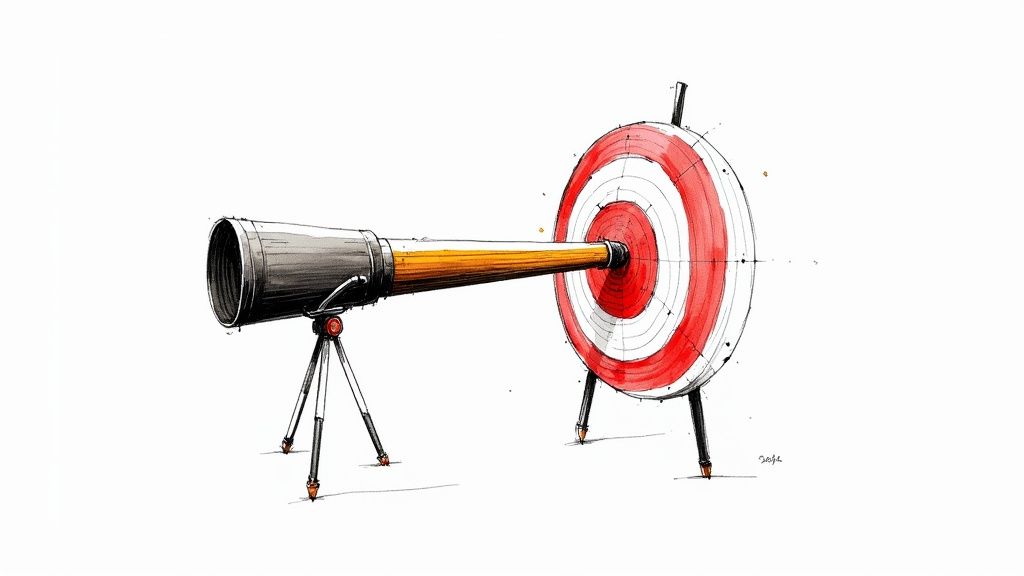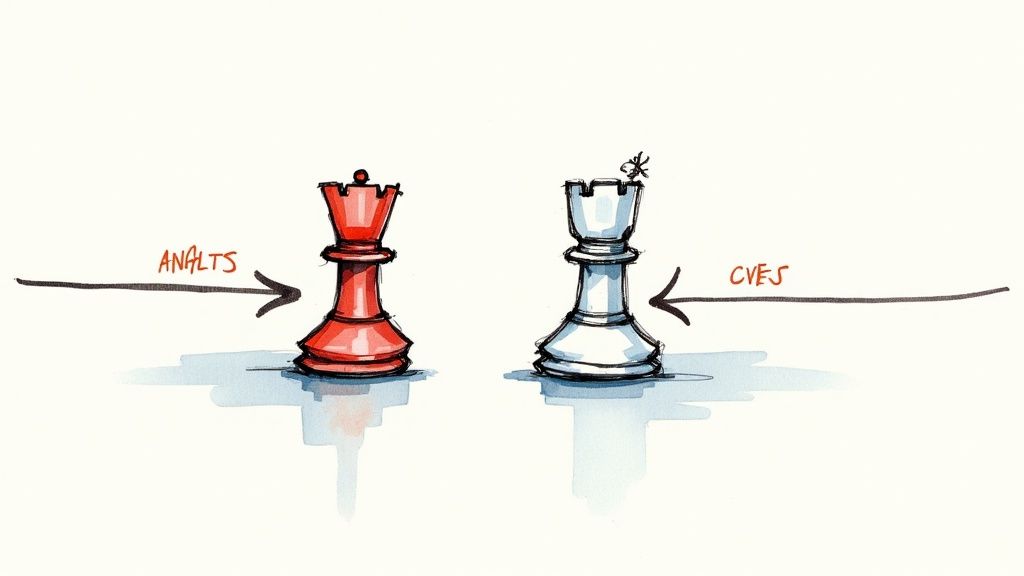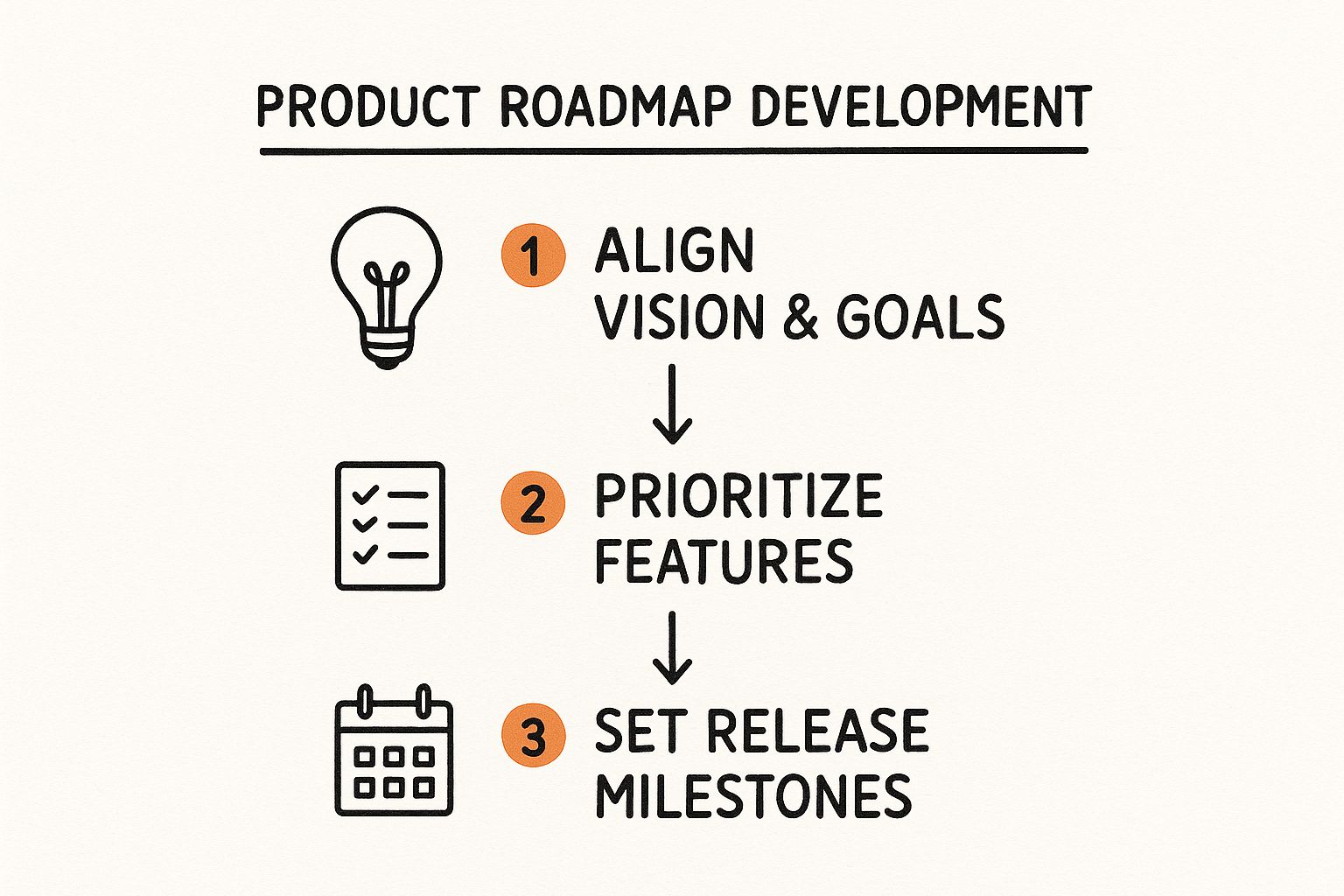Table of Contents
Why Most Product Teams Struggle Without Frameworks
The Value of a Shared Strategic Language
How Smart Companies Ditched Rigid Planning for Adaptive Frameworks
Embracing Uncertainty, Maintaining Direction
From Fixed Roadmaps to Flexible Frameworks
The Essential Building Blocks That Make Frameworks Actually Work
Vision and Positioning: The Foundation
Market Analysis and Internal Capabilities: Building the Walls
Competitive Intelligence: Securing the Roof
Connecting the Pieces for a Solid Structure
From Brand Managers to Strategic Product Leaders
The Rise of the Strategic Product Leader
The Importance of Strategic Thinking and Tactical Execution
Your Step-by-Step Framework Implementation Journey
Building a Foundation of Shared Understanding
Building Strategic Capabilities Over Time
Framework Success Stories That Changed Everything
Netflix: From DVDs to Streaming Dominance
Spotify: Challenging the Music Industry Giants
Learning From Both Wins and Losses
Measuring Success and Avoiding Framework Disasters
Beyond Vanity Metrics: Measuring Real Progress
Recognizing the Warning Signs of Framework Drift
Why Most Product Teams Struggle Without Frameworks
Imagine a group of talented musicians trying to jam without a shared understanding of rhythm or key. The result? A jumbled mess, wasted effort, and a disappointing performance. This is often what it looks like when product teams lack a product strategy framework. Individual brilliance is there, but without a structure to channel their efforts, it's not enough.
This lack of a framework often shows up as features driven by the loudest voice, knee-jerk reactions to competitors, and a constant feeling of being busy without making real progress. Meanwhile, competitors systematically gain ground with products that seem to anticipate market needs. They're not necessarily smarter; they’re just more strategic.
The Value of a Shared Strategic Language
A well-defined product strategy framework is crucial for aligning everyone towards shared business goals. Product strategy defines the why, who, and how of a product. It prioritizes crucial aspects like features and timelines, ensuring everything aligns with the company's vision. Discover more insights into product strategy frameworks.
This framework creates a common language and understanding of where you're going. It helps teams make consistent decisions, even under pressure, by providing clear criteria for evaluating opportunities and trade-offs.
Transforming Chaos into Focus
Frameworks transform chaotic “feature factories” into focused product machines. They equip teams with the tools to:
- Prioritize effectively: Not all features are created equal. Frameworks help separate the essential from the nice-to-haves.
- Allocate resources strategically: Time, budget, and talent are limited. Frameworks guide their allocation to the most impactful initiatives.
- Measure progress meaningfully: Frameworks establish key performance indicators (KPIs) that truly reflect strategic progress, going beyond superficial metrics.
Learning from the Giants
Think about Apple. Their products often feel inevitable, as if they knew what customers wanted before they did. This isn't magic; it's the result of rigorous, framework-driven thinking. Similarly, Amazon’s leadership principles permeate their product decisions, creating a consistent customer focus that has fueled their growth.
Intuition and gut feelings are valuable, but they need the support of a framework to consistently deliver winning products. A solid framework channels individual creativity toward a shared vision, ensuring the final product resonates with the market and achieves its goals. It's the difference between a random collection of notes and a beautifully composed symphony.
Ready to drive more growth & achieve bigger impact?
Leverage my 25+ years of successes and failures to unlock your growth and achieve results you never thought possible.
Get StartedHow Smart Companies Ditched Rigid Planning for Adaptive Frameworks

Remember Blockbuster? They meticulously charted their future, convinced of the enduring reign of brick-and-mortar stores. Then came Netflix, disrupting everything with a different approach: an adaptive framework built for the uncertain world of streaming. Blockbuster's rigid plan, like a concrete block, couldn't weather the changing tides. This story perfectly illustrates a fundamental shift in product strategy: the move away from rigid long-term plans towards flexible frameworks.
This shift wasn't random. Product strategy has changed drastically over time, responding to shifting markets and new technologies. Long-term plans were once the norm, but now, it's all about flexibility and reacting quickly. Companies clinging to old plans, like Kodak with film cameras in the digital age, were left behind. Discover more insights on the evolution of product strategy.
The Rise of Agile Thinking
Agile methodologies played a huge role in this change. Agile introduced iterative development, breaking big projects into smaller, more manageable pieces. This same thinking influenced strategy, allowing companies to experiment, learn, and adapt quickly. One effective way to manage these smaller tasks and improve workflow is through Kanban boards, particularly useful for non-technical teams.
Embracing Uncertainty, Maintaining Direction
The goal isn't to abandon strategy altogether. It's about creating product strategy frameworks that are structured yet adaptable. Think of a sailboat: the sail provides direction and power, while the rudder allows for course correction. Modern frameworks offer this same balance.
From Fixed Roadmaps to Flexible Frameworks
Successful companies today accept uncertainty as a constant. They use frameworks to set a general direction, but build in ways to continuously adjust. They study market feedback, watch new trends, and adapt their strategies accordingly. This constant feedback loop helps them stay ahead of the game and maintain a competitive edge in unpredictable markets. The result? Products that meet changing customer needs and businesses that thrive in a constantly evolving world.
The Essential Building Blocks That Make Frameworks Actually Work

A successful product strategy framework isn't about abstract ideas. It's about tangible, interconnected parts working together. Think of building a house. You need a solid foundation, sturdy walls, and a dependable roof. If one piece is missing, the whole structure is weak. A framework is the same – it needs essential elements working in harmony.
Vision and Positioning: The Foundation
Every strong framework starts with a clear vision and positioning. This isn't just business jargon; it's the bedrock of every decision. Take Spotify, for instance. Their vision of "music for everyone" guides countless daily decisions, from new features to marketing campaigns. A clear vision provides direction and keeps the team focused on the overall goal.
Positioning clarifies your product's unique value. It's how you stand out from the crowd. Slack, for example, positioned itself not just as another messaging app, but as a central collaboration hub. This distinction resonated with businesses looking to streamline their communication.
Market Analysis and Internal Capabilities: Building the Walls
Next comes market analysis. This is the process of understanding customer needs and market trends. Slack, again, provides a good example. They identified a gap in the market for efficient team communication – a need existing tools weren't meeting effectively. Thorough market analysis helps uncover opportunities and reveals the potential for growth.
But identifying a market need isn't enough. You also need to assess your internal capabilities. Can your team deliver on the promises of your product strategy? This honest self-assessment helps you avoid overpromising and underdelivering, a common problem for product teams.
Competitive Intelligence: Securing the Roof
Finally, competitive intelligence acts as a protective layer, shielding your framework from outside threats. By understanding your competitors' strengths and weaknesses, you can find your competitive edge. This isn't about copying; it's about finding your own unique advantage. For instance, studying competitor pricing models might reveal an opportunity to offer a more attractive subscription.
To help illustrate how these essential components fit together, let's take a look at the table below. It breaks down the purpose, key questions, and outputs of each element within your product strategy framework.
Essential Framework Components Comparison
| Component | Primary Purpose | Key Questions | Typical Outputs |
|---|---|---|---|
| Vision & Positioning | Define the overall direction and unique value proposition | What problem are we solving? Who are our target customers? What makes us different? | Vision statement, Positioning statement, Target customer profile |
| Market Analysis | Understand customer needs, market trends, and growth opportunities | What are the unmet needs in the market? What are the current market trends? What is the market size and potential? | Market research reports, Customer segmentation analysis, Competitive landscape analysis |
| Internal Capabilities | Evaluate resources and expertise to ensure successful execution | What are our strengths and weaknesses? Do we have the necessary skills and resources? Can we realistically deliver on our promises? | SWOT analysis, Resource allocation plan, Gap analysis |
| Competitive Intelligence | Identify competitive threats and opportunities | Who are our main competitors? What are their strengths and weaknesses? How can we differentiate ourselves? | Competitor analysis reports, Pricing analysis, Market share data |
As you can see, each component plays a vital role in building a robust product strategy. Understanding their individual purposes and how they relate to each other is crucial for success.
Connecting the Pieces for a Solid Structure
These components aren't isolated. They must work together seamlessly to create a coherent strategy. This interconnectedness is critical. A team might have a fantastic vision, but if they don't understand their internal capabilities, they'll struggle. Thorough market analysis without competitive intelligence can leave a team vulnerable. The key is to ensure these components reinforce each other, creating a robust and adaptable product strategy framework. This creates a solid framework to support informed decision-making and guide product development towards meaningful results.
From Brand Managers to Strategic Product Leaders

The product leader role has changed dramatically. It's like comparing a rotary phone to a smartphone – both facilitate communication, but the scope and complexity are vastly different. This evolution mirrors the growing complexity of products themselves and the ever-shifting landscape of the market.
Back in the 1930s, Procter & Gamble introduced the brand manager. Imagine this person as the chief cheerleader for their assigned brand, focused on marketing, sales, and consistent messaging. A vital role, yes, but with a limited scope. This marked the beginning of the evolution of product management, intertwined with the development of product strategy frameworks. Learn more about the evolution of product management here.
The Rise of the Strategic Product Leader
Today, product leaders are more like strategic architects. They're responsible for the entire product lifecycle, from initial idea to market triumph, impacting overall business results. This shift happened alongside the development of product strategy frameworks. As products became more sophisticated and markets more unpredictable, a systematic, strategic approach became essential. Think of these frameworks as a blueprint for success, guiding the entire process. Effective product strategy frameworks often incorporate prioritization techniques, like using a revenue-weighted backlog, which can be a powerful tool for focusing on the most impactful initiatives.
Modern product leaders blend market intuition with financial savvy and strategic frameworks. They're data-driven, understanding both the big picture and the finer details. They juggle stakeholder relationships, prioritize competing demands, and guide their teams toward measurable outcomes. You might also consider exploring fractional leadership to bolster your strategic product goals.
The Impact of Agile
Agile methodologies had a profound impact on this evolution. It wasn't just about faster development; it was a fundamental shift in how product leaders approach strategy. Agile emphasizes iterative development, continuous feedback, and adapting quickly to market changes. This approach requires a mindset that embraces experimentation and learning, like navigating a ship by constantly adjusting course based on wind and current.
The Importance of Strategic Thinking and Tactical Execution
Today's frameworks require a different skill set than traditional planning. Leaders need to balance strategic thinking with the nitty-gritty of tactical execution. Here's what that looks like:
- Analyze market trends: Understanding what customers want and what the competition is doing.
- Develop financial models: Projecting the financial impact of product decisions and justifying investments.
- Build and manage high-performing teams: Motivating and empowering team members to achieve shared goals.
- Implement and iterate on frameworks: Adapting strategies based on data and feedback, much like a gardener tending to their plants based on weather and growth.
Companies that invest in strong product leadership see greater success with framework implementation. These leaders drive successful product strategies, ensuring frameworks are practical tools for tangible results, not just theoretical documents. They connect strategy and execution, creating products that satisfy market needs and deliver sustainable growth.
Your Step-by-Step Framework Implementation Journey

The infographic above gives a quick overview of creating a product roadmap: aligning your vision and goals, prioritizing features, and setting those all-important release milestones. It shows how a well-structured product strategy framework works – each step builds on the last, creating a roadmap that’s both strategic and something you can actually use.
Putting a product strategy framework into action isn’t always easy. It’s like learning to play jazz – you might know the notes, but making real music takes practice. This section helps you navigate the real-world challenges of putting a framework into practice, sharing insights into what works and what doesn't.
Building a Foundation of Shared Understanding
Implementation starts with getting everyone on board. We're not talking about head nods and smiles, but genuine buy-in from stakeholders. Run workshops that uncover real priorities and limitations. This turns passive observers into active participants, building a shared understanding of why the framework matters and what it can do. Understanding the various roles is key, and a good place to start is understanding the difference between product and engineering managers.
Navigating the Messy Middle
Implementation is rarely a straight line. Expect competing priorities, limited resources, and pushback against change. Successful companies anticipate these hurdles. They build flexibility into the framework, allowing it to adapt as things change. They also make sure communication is clear, keeping everyone informed and engaged throughout the process. For a deeper dive into implementation, check out this resource on implementing the AARRR framework.
Measuring What Matters
Forget vanity metrics. Focus on the numbers that truly reflect progress towards your strategic goals. Early warning signs, like lower customer engagement or missed deadlines, should trigger adjustments. Airbnb, for example, constantly refines its framework based on market feedback and what they learn internally. This iterative approach is essential for long-term success.
Building Strategic Capabilities Over Time
Implementing a framework is a journey, not a destination. Think of it as a skill that gets better with practice. Set realistic timelines and expectations. Don’t expect miracles overnight. Focus on building strategic capabilities that grow over time, gradually transforming your team into a strategic powerhouse. This takes patience, persistence, and a willingness to learn and adapt along the way.
The payoff? A well-implemented framework creates a culture of strategic thinking, letting your team consistently deliver products that meet market needs and drive sustainable growth.
Here’s a handy timeline to guide your implementation:
The following table, "Framework Implementation Timeline", offers a detailed look at each phase of implementation, including timeframes, key activities, who's involved, and how you'll measure success.
| Phase | Duration | Key Activities | Stakeholders | Success Metrics |
|---|---|---|---|---|
| Phase 1: Assessment & Planning | 4-6 weeks | * Define objectives and scope * Conduct stakeholder interviews * Gap analysis * Resource allocation * Develop implementation plan | Product team, Executive sponsors, Key stakeholders | * Clearly defined objectives and scope * Stakeholder buy-in * Comprehensive implementation plan * Secured budget and resources |
| Phase 2: Framework Rollout | 8-12 weeks | * Training and workshops * Pilot program * Initial framework deployment * Communication and feedback gathering | Product team, Development team, Marketing team | * Successful completion of training * Positive pilot program results * Initial framework adoption across teams * Early feedback collected and addressed |
| Phase 3: Optimization & Refinement | Ongoing | * Performance monitoring and analysis * Framework adjustments based on feedback and results * Continuous improvement initiatives * Best practice sharing | Product team, All stakeholders | * Improved product performance (e.g., increased customer satisfaction, faster time-to-market) * Increased stakeholder satisfaction * Framework effectively adapted to changing business needs * Continuous learning and improvement culture |
This timeline gives a general overview, and the duration of each phase can vary based on the complexity of your framework and the size of your organization. The key takeaway here is to approach implementation strategically, measure what matters, and commit to continuous improvement.
Framework Success Stories That Changed Everything
Real-world success stories are the best way to illustrate the power of a product strategy framework. These aren't just inspiring tales; they're packed with valuable lessons about the choices, hurdles, and results that shape winning products. Let's dive into two examples: Netflix and Spotify.
Netflix: From DVDs to Streaming Dominance
Netflix's transformation from a DVD rental service to a streaming powerhouse is a prime example of adaptive framework thinking. Initially, their framework focused on mail-order efficiency. But as technology changed, so did their strategy.
They saw the potential of streaming early on, a strategic move that demanded serious investment and a willingness to disrupt their own successful business. This wasn't a simple tech upgrade; it was a fundamental shift in their product strategy framework. They had to develop new skills in content acquisition, build a streaming infrastructure, and design a compelling user experience.
The following screenshot shows Netflix's current focus on original content and global reach, a core piece of their evolved product strategy:
Netflix's focus on "stories" highlights their evolution from content distributor to entertainment creator. This shift is clear in their investment in original programming and their personalized recommendations. Their success underscores the importance of adapting a framework to shifting market conditions and new technologies.
Spotify: Challenging the Music Industry Giants
Spotify entered a market dominated by giants. Their success wasn't about outspending them, but outsmarting them with a focused, organized approach. Their product strategy framework focused on building a smooth and legal music streaming experience, addressing user frustrations with piracy and limited music libraries.
Their framework highlighted several key elements:
- Freemium Model: A free, ad-supported version to attract a broad audience, paired with a premium subscription for a better experience.
- Collaborative Playlists: Social music discovery and sharing built a sense of community and drove organic growth.
- Data-Driven Personalization: Using user data to craft personalized recommendations and playlists, boosting engagement and retention.
This strategic mix allowed Spotify to quickly grab market share, disrupting the traditional music industry. They concentrated on user experience and personalized recommendations, creating a lasting competitive edge.
Learning From Both Wins and Losses
These successes weren't without their challenges. Both Netflix and Spotify faced obstacles, made missteps, and adjusted their frameworks along the way. Netflix's initial push into original content wasn't an overnight hit. It required lots of testing and learning. Spotify faced legal and licensing issues that threatened their core business.
These stories highlight the importance of constantly improving and learning from both wins and losses. By studying these real-world examples, we gain practical understanding of the power of frameworks. They show how strategic thinking can reshape industries, build competitive advantages, and create products that resonate with the market.
These stories are both inspiring and realistic. They show us that frameworks aren't rigid blueprints. They’re adaptable tools that help us navigate the complexities of product development and achieve long-term success.
Measuring Success and Avoiding Framework Disasters
Building a solid product strategy framework is a lot like building a race car. You painstakingly choose the best components, assemble them with care, and then…what? You don't just leave it in the garage. You take it to the track, test its limits, and constantly monitor its performance. That’s where measurement and ongoing refinement come into play. Even the best-designed frameworks can fail without them.
Beyond Vanity Metrics: Measuring Real Progress
Many teams get caught up in tracking vanity metrics – numbers that look good but don't reflect real strategic progress. Imagine tracking social media followers without looking at engagement or conversions. It’s like a packed stadium where no one bought tickets. A successful product strategy framework needs metrics tied directly to your strategic goals.
These metrics should be:
- Actionable: They should give you insights that help you make decisions and take specific actions.
- Measurable: Use quantifiable data that tracks progress towards your goals.
- Relevant: The data should directly connect to your overall product strategy and business objectives.
- Time-bound: Track metrics over specific periods to monitor progress and spot trends.
For example, if you want to boost user engagement, track metrics like active users, session duration, and feature usage. To improve customer retention, monitor churn rate, customer lifetime value, and customer satisfaction scores.
Recognizing the Warning Signs of Framework Drift
Even with the right metrics, framework drift can happen. This is when your team gets caught up in the day-to-day and slowly veers off course from your strategic intentions. Think of a ship slowly drifting off course due to subtle currents. Spotting the early warning signs is key:
- Missed Deadlines: Consistent delays might signal a disconnect between your strategy and execution.
- Declining Key Metrics: A dip in your chosen metrics indicates a potential problem with your framework.
- Stakeholder Dissatisfaction: Negative feedback from key stakeholders suggests misaligned priorities.
- Decreased Team Morale: If your team feels lost or unmotivated, your framework might not be providing clear direction.
Addressing these issues requires open communication with product leaders and stakeholders. Honest conversations about what’s working and what’s not are essential for course correction. For more insights on team dynamics and motivation, check out this post: Sustaining Momentum Within Product Development Teams.
Maintaining Strategic Discipline While Embracing Change
Maintaining strategic discipline isn't about rigidly sticking to the initial plan. The market changes, and your framework must adapt. It's like steering a ship through changing weather – you need a steady hand while constantly adjusting course.
Regular framework health checks are essential. These checks should involve:
- Gathering Stakeholder Feedback: Understand their views on the framework's effectiveness.
- Analyzing Key Metrics: Assess your progress toward your strategic goals.
- Reviewing Market Trends: Stay informed about changes in the competitive landscape.
Using these insights, you can make informed decisions about refining your framework. This might involve tweaking metrics, adjusting priorities, or even revisiting your overall product vision.
Avoiding Bureaucratic Bottlenecks
Sometimes, well-intentioned frameworks become bureaucratic roadblocks, slowing teams down with unnecessary processes. It’s like building a racecar with a heavy, inefficient engine. It looks the part, but won't win any races.
To avoid this, keep your framework lean and agile. Focus on the essential elements that drive strategic decision-making. Regularly review your processes and cut out unnecessary steps. Empower your team to make decisions within the framework's guidelines, fostering autonomy and ownership.
This section highlights the critical, yet often overlooked, aspects of framework management. By focusing on measurement, recognizing warning signs, embracing adaptability, and avoiding unnecessary bureaucracy, your product strategy framework can be a powerful engine for growth and innovation.
Ready to drive more growth & achieve bigger impact?
Leverage my 25+ years of successes and failures to unlock your growth and achieve results you never thought possible.
Get Started
